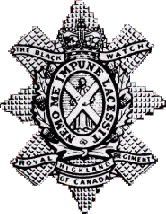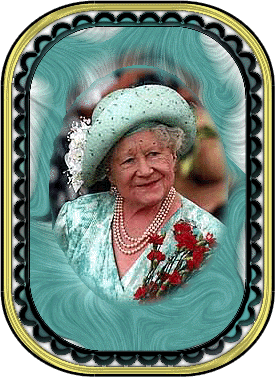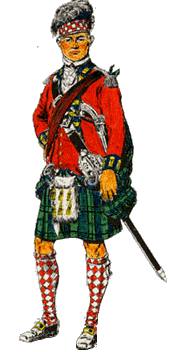
"42nd Royal Highland Regiment"

"The Black Watch"

"Nemo Me Impune Lacessit"
(no one provokes me with impunity)


Brief History of the Black Watch
The Black Watch (Royal Highland Regiment) was the
first kilted regiment in the British Army,
and the first to introduce the bagpipe.
It's the oldest Highland regiment and can trace a line
back to 1624, when the government of the day
started raising Independent Companies to keep a
check on the wild clansmen
In the wake of the 1715 Scottish rebellion, companies
of trustworthy Highlanders were raised from loyal clans.
They became known as "The Black Watch"
for the watch they kept on the Highlands and
from their dark government tartan.
In 1739 King George II authorized the companies
be formed into a regiment of foot,
"the men to be natives of that country,
and none other to be taken".
That same year they held their first regimental parade
on the banks of the River Tay at Aberfeldy.
The Regiment's first blooding occurred in Flanders in 1745,
in the war of Jenkin's Ear at the Battle of Fontenoy,
where the French dubbed them "Highland Furies".
In 1751 the Regiment was numbered the 42nd,
"The Gallant Forty Two".
Seven years later the title "Royal" was granted and
it became the 42nd Royal Highland Regiment.
The Regiment then saw action in the Americas,
most notably in Ticonderoga and the Heights of Abraham,
and acquired its present badge and motto
"Nemo me impune lacessit"
which refers to the Thistle and means
"nobody provokes me without being hurt"
In 1759 the red hackle, seen in the feather bonnets
and worn by all ranks of the Black Watch,
was first presented at Royston, in Hertfordshire.
During the Napoleonic Wars the Regiment
fought at the Battle of Alexandria
(hence the Sphinx and the word Egypt on its colours),
in the Peninsula, including Corruna, and finally at
Quatre Bras and Waterloo.
Its 19th century battle honours include
Alma and Lucknow, and in the 1860s Queen Victoria
authorised the addition of the name "The Black Watch"
to the official title of the 42nd Royal Highlanders,
a title which has become known throughout the world.
In World War One, 11 Battalions of the Regiment fought in
France and Flanders, Macedonia, Mesopotamia and Palestine.
Her Majesty Queen Elizabeth
The Queen Mother

Colonel-in-Chief Since 1937
42d Royal Highland Regiment
Her Majesty Queen Elizabeth, The Queen Mother,
had two brothers and a first cousin in the 5th Battalion,
another brother killed in 1915 with the 8th and a cousin
killed serving with 4/5th.
Armistice Day found the Regiment advancing across
the very field at Fontenoy where the Watch had fought
173 years before.
The French commemorated the stalwart assistance
given to them in Champagne in 1918 by erecting a cairn
on the spot where fell the body of The Black Watch
soldier who advanced the furthest
"Here shall flourish for ever the glorious thistle of Scotland
among the roses of France".
In World War II the Regiment was present at Dunkirk and
fought at Crete, Tobruk, El Alamein, Sicily, Normandy,
Ardennes and Burma.
Indeed, its five Battalions saw service in every major
theatre of war except Norway and Malaya.
Its long association with Perth, Scotland, is retained by maintaining
at Balhousie Castle its Headquarters and Regimental Museum.
More recently the Battalion served in Hong Kong between
January 1993 and August 1994 before returning to the
United Kingdom and undertaking a tour of
West Belfast in Northern Ireland.
In July 1996 the Battalion returned home to Scotland and
is currently stationed in Fort George in Inverness.
In February 1997 they became the last
UK Infantry Battalion to serve in Hong Kong.

The Seven Years War
May, 1740
Black Watch formed into 43rd regiment,
from the Independant Companies raised in 1720's
1749
Black Watch renumbered 42nd
1756
Black Watch comes to America,
spends remainder of 1756 inactive in Albany
Winter/Spring 1757
Black Watch drilled for bush fighting and sharpshooting
1758
Black Watch given 'Royal' designation
before Ticonderoga. 2nd Bn. raised
July, 1758
British forces engage Montcalm's French at
Ticonderoga
Black Watch participates in famed charge
on French lines and attempt to storm the breastwork,
losing 315 killed, and 333 wounded.
"The battle was not regarded as a disaster,
but as a triumphant display of Highland gallantry.
Though it achieved nothing, it showed a
heroic temper, and without a heroic temper,
an army is worth very little."
"The Black Watch"
22 July, 1758
Actually recieved word of the 'Royal'
designation, leading many to believe it was
given in honor of the regiment's bravery
at Ticonderoga
Winter 1758
Spend winter rebuilding ranks on Long Island
1759
2nd Bn. sent to West Indies.
Later sent to Oswego while the 1st Bn. was
at Ticonderoga and Crown Point
May 1759
1st Bn. Participated in actions at Ticonderoga,
Crown Point, and the lakes under Amherst
2nd Bn. brought in with the 1st Bn. for the winter
1760
Both battalions served in the army under
Amherst, which moved down the St. Lawrence.
Recieved the surrender of Montreal, together with that
of the French Governor-General and the French army
Winter 1760-61
Both battalions remained in Montreal for the winter
4 April - 5 August, 1761
Moved from Montreal to Staten Island,
to set out for West Indies
1761
Black Watch leaves America for Barbados
to join armament against Martinique and Havana
Summer 1763
Black Watch and a detachment of
Montgomery's Highlanders sent to the relief of Fort Pitt
5 August, 1763
Light and grenadier companies, along with
Henri Bouquet's Royal Americans,
ambushed by Indians at Bushy Run.
After suffering 29 killed and 36 wounded, the
Indians were routed
1763
Regiment arrived at Fort Massac on the
Ohio River, only to find it burned to the ground
Winter 1763
Spent winter at Fort Pitt
Summer 1764
8 companies sent with a force under
Col. Boquet against Ohio Indians.
Returned to Fort Pitt in January, 1765.
Regiment took possession of Fort DeChartres
on the Mississippi, in a carefully
choreographed ceremony
July, 1767
Left Philidelphia for Cork, Ireland
1775
Black Watch returned to Scotland,
gaining two companies


The American Revolution
1 May, 1776
Sailed for America
3 August, 1776
Black Watch landed on Staten Island
27 August, 1776
Battle on Long Island and Brooklyn
16 September, 1776
Battle of Harlem ("York Island")
November 16, 1776
Fort Washington taken by British forces,
including the Black Watch
December 22, 1776
Action at BlackHorse on the Delaware
Winter 1776-1777
Black Watch takes up winter quarters in Brunswick
February 13, 1777
Action at Amboy, New Jersey
May 10, 1777
Battle of Pisquata (Piscataway), New Jersey
5 September, 1777
Participated in a raid of privateer ships
11 September, 1777
Battle of Brandywine (Pennsylvania)
5 October, 1777
Light Company, 42nd regiment participated in the
"Battle of Germantown"
Winter 1777-1778
Encamped at Philadelphia for the winter
April 1778
Expedition to destroy military stores in Portsmouth, Virginia
28 June, 1778
Battle of Monmouth, Jerseys
26 February, 1779
Battle at Elizabethtown, Jerseys
1779
Remainder of 1779 spent in actions at
Garrison, Stony Point, and Vereplanck, New Jersey
Spring, 1780
Black Watch participated in seige of Charleston
Winter 1781
Black Watch takes up winter quarters in New York
September-October 1781
Light Company, 42nd regiment participated in the
"Battle of Yorktown"
Summer 1782
While stationed at Paulus Hook, one private named
Anderson was court martialed and shot for desertion,
the first desertion since 1743
22 October, 1783
Left New York for Halifax, Nova Scotia
1786
42nd left Halifax for Cape Breton
August, 1789
Black Watch returned home, arriving in
Glasgow in May 1790
A Black Watch Quote
about the "American Revolution"
"We can boast no Battle Honours for our part
in the American War of Independance,
because it was rightly decreed that Battle Honours
should not be granted for a war with our kith and kin"

History Of The Bagpipes
The Bagpipe has a long and honorable
history stretching back to the beginnings of
civilization, for it is one of the oldest of
instruments played by man
It probably had its beginnings in ancient
Egypt where a simple chanter and drone
were played together, and as time went by,
they were attached to a bag, and a blowstem
was added. This primitive bagpipe was
played by the Greeks and Romans, and
eventually spread thoughout Europe
It was popular though the ages, and was one
of the most common instruments during the
Middle Ages. In more modern times, the
bagpipe evolved, and became capable of a
wider range of notes, and was played by a
bellows held under the arm. Though in the
18th century, when towns and cities began to
flourish, and people began to move from
villages and making music in the open,
favoring the elaborate instruments of today.
This caused the bagpipe to die out, for the
most part all over Europe, save in Brittany,
where it survives to this day
The pipes can still be seen and heard in some form
(usually a single-droned form)
in many European countries, such as Spain
In Britain, the history of the bagpipe followed
the same pattern that it did in continental Europe,
except in the Highlands of Scotland.
The pipes' martial music appealed to the Scots,
and it became their instrument of choice at an early date.
Around 1500, a second drone was added, and
around 1700, a 3rd (the big one) drone was added,
giving the bagpipe as we know it today
After the Uprising of 1745, the playing of the pipes
was forbidden in Scotland, but it was kept alive in
secret, and once the ban was lifted, bagpipe music
began to flourish.
Highland societies were set up in London, Edinburgh
and elsewhere for the purpose of keeping alive the
traditions of the Highlands culture.
The pipes became the most popular music for
Scottish soldiers, (who were, in increasing numbers)
being enlisted in the British army.
This spread their poularity and helped their survival,
and the pipes can be heard today wherever men of the
Scottish race have traveled

click "Control Center" to
return to the site options







click "Control Center" to
return to the site options
